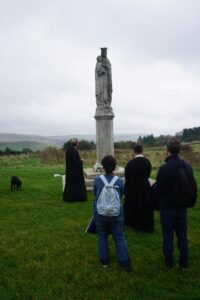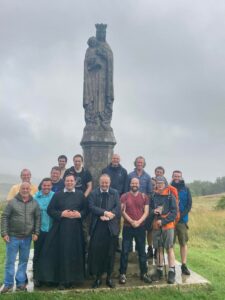Download a free PDF of the Pilgrim Handbook for Our Lady of Penrhys or purchase a paperback edition.
 Legend tells that a statue of the Blessed Virgin Mary, seated and holding Our Lord, appeared in the branches of an oak tree near to the holy well, Ffynnon Fair. The statue was said to have been incredibly beautiful and a gift from heaven. Many people tried to remove the statue from the tree, but it resisted all attempts to the point where ‘Eight oxen could not have drawn the Image of Penrhys from its place…’ The statue would only allow itself to be retrieved once a chapel and shrine were built on the brow of Cefn Penrhys.
Legend tells that a statue of the Blessed Virgin Mary, seated and holding Our Lord, appeared in the branches of an oak tree near to the holy well, Ffynnon Fair. The statue was said to have been incredibly beautiful and a gift from heaven. Many people tried to remove the statue from the tree, but it resisted all attempts to the point where ‘Eight oxen could not have drawn the Image of Penrhys from its place…’ The statue would only allow itself to be retrieved once a chapel and shrine were built on the brow of Cefn Penrhys.
For centuries, the faithful of Wales made pilgrimages to the shrine at Penrhys, receiving answers to their prayers through Our Lady’s intercession. Among the prayers answered at the Shrine were for healing of the Pilgrims. Both the Image of Our Lady and her well below the Shrine Chapel were the site of many miraculous cures attested to by poets and pilgrims alike.
Devotion to Our Lady at Penrhys centred around the Five Joys of Mary. Combined with devotion to Our Lady as Sedes Sapientiæ, Seat of Wisdom, these were the two principal images of Our Lady associated with Penrhys. This very early Rosary connection is striking, in that it was the Cistericians who had the cure of souls there rather than the Dominicans.
 The original statue survived at Penrhys until 1538 when, under Henry VIII’s violent breaking of full communion with the Apostolic See of Rome, the notorious Protestant Bishop Latimer wrote to Thomas Cromwell suggesting the destruction of the shrine. With the shrine burned during the night, the statue was taken to London where it was publicly burned with other Marian images, including that of Our Lady of Walsingham.
The original statue survived at Penrhys until 1538 when, under Henry VIII’s violent breaking of full communion with the Apostolic See of Rome, the notorious Protestant Bishop Latimer wrote to Thomas Cromwell suggesting the destruction of the shrine. With the shrine burned during the night, the statue was taken to London where it was publicly burned with other Marian images, including that of Our Lady of Walsingham.
The ruins of the Shrine of Our Lady of Penrhys were still visited throughout the centuries of persecution of the faithful, with records showing devotion as late as 1842; though by this date little of the original shrine survived.
In the late Nineteenth Century, a replica of the destroyed statue was placed in a Catholic Church in Ferndale, in the valley below the mountain. This served as the focal point for pilgrimage until mid-century.
On 2nd July 1953, a new statue was revealed and consecrated by His Grace, the Most Rev. Michael Joseph McGrath, Archbishop of Cardiff and Metropolitan of Wales, at the site of the ruined chapel. Standing on a plinth and much larger than the original, the new Image of Our Lady was carved from Portland stone using the descriptions left behind in medieval Welsh poetry. More than 20,000 people attended the first pilgrimage after the erection of the new statue.
Due to its religious importance, Penrhys is part of the Cistercian Way, and many people still make pious pilgrimages to the site every year.